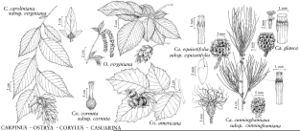Difference between revisions of "Casuarina equisetifolia subsp. equisetifolia"
FNA>Volume Importer |
FNA>Volume Importer |
||
| Line 19: | Line 19: | ||
}}<!-- | }}<!-- | ||
| − | --><span class="statement" id="st- | + | --><span class="statement" id="st-undefined" data-properties=""><b>Trees,</b> 7-35 m, not suckering. <b>Bark</b> gray-brown to black, scaly. <b>Branchlets</b> drooping; segments 5-8[-13] × 0.5-0.7[-1] mm, usually densely pubescent at least in furrows, not waxy; longitudinal ridges angular with median rib; teeth not marcescent, (6-)7-8, erect, 0.3-0.8 mm. <b>Young</b> permanent shoots with erect to spreading teeth. <b>Flowers</b> unisexual, staminate and pistillate on same plant. <b>Staminate</b> spikes 0.7-4 cm, 7-11.5 whorls per cm; anthers 0.6-0.8 mm. <b>Infructescences</b> sparsely pubescent [tomentose]; peduncles 3-10 mm; infructescence body 12-24 × 9-11 mm; bracteoles acute. <b>Samaras</b> 6-8 mm.</span><!-- |
-->{{Treatment/Body | -->{{Treatment/Body | ||
| Line 25: | Line 25: | ||
|habitat=Sandy seasides, native to tropical and subtropical coastlines | |habitat=Sandy seasides, native to tropical and subtropical coastlines | ||
|elevation=0-20 m | |elevation=0-20 m | ||
| − | |distribution=Fla.;native;Southeast Asia;native;s Pacific Islands (e to Tahiti and Samoa);native;Australia | + | |distribution=Fla.;native;Southeast Asia;native;s Pacific Islands (e to Tahiti and Samoa);native;Australia. |
|discussion=<p>Casuarina litorea Rumphius ex Stickman is not a valid name.</p><!-- | |discussion=<p>Casuarina litorea Rumphius ex Stickman is not a valid name.</p><!-- | ||
--><p>Casuarina equisetifolia is widely cultivated in many parts of the world because of its salt tolerance; it is now considered an invasive pest in parts of Florida. Only C. equisetifolia subsp. equisetifolia is known from the flora area. Casuarina equisetifolia subsp. incana (Bentham) L. A. S. Johnson, from Australia and the Pacific Islands region, is cultivated elsewhere in the world and possibly has been introduced to (although not yet discovered in) the flora area. That subspecies is a smaller tree with a more rounded crown, longer and thicker branchlets, and more pubescent branchlets and infructescences.</p> | --><p>Casuarina equisetifolia is widely cultivated in many parts of the world because of its salt tolerance; it is now considered an invasive pest in parts of Florida. Only C. equisetifolia subsp. equisetifolia is known from the flora area. Casuarina equisetifolia subsp. incana (Bentham) L. A. S. Johnson, from Australia and the Pacific Islands region, is cultivated elsewhere in the world and possibly has been introduced to (although not yet discovered in) the flora area. That subspecies is a smaller tree with a more rounded crown, longer and thicker branchlets, and more pubescent branchlets and infructescences.</p> | ||
| Line 46: | Line 46: | ||
|habitat=Sandy seasides, native to tropical and subtropical coastlines | |habitat=Sandy seasides, native to tropical and subtropical coastlines | ||
|elevation=0-20 m | |elevation=0-20 m | ||
| − | |distribution=Fla.;native;Southeast Asia;native;s Pacific Islands (e to Tahiti and Samoa);native;Australia | + | |distribution=Fla.;native;Southeast Asia;native;s Pacific Islands (e to Tahiti and Samoa);native;Australia. |
|introduced=true | |introduced=true | ||
|reference=None | |reference=None | ||
| Line 52: | Line 52: | ||
|publication year= | |publication year= | ||
|special status=Selected by author to be illustrated;Introduced | |special status=Selected by author to be illustrated;Introduced | ||
| − | |source xml=https://jpend@bitbucket.org/aafc-mbb/fna- | + | |source xml=https://jpend@bitbucket.org/aafc-mbb/fna-data-curation.git/src/9216fc802291cd3df363fd52122300479582ede7/coarse_grained_fna_xml/V3/V3_51.xml |
|genus=Casuarina | |genus=Casuarina | ||
|species=Casuarina equisetifolia | |species=Casuarina equisetifolia | ||
|subspecies=Casuarina equisetifolia subsp. equisetifolia | |subspecies=Casuarina equisetifolia subsp. equisetifolia | ||
| − | |||
| − | |||
| − | |||
| − | |||
| − | |||
| − | |||
| − | |||
| − | |||
| − | |||
| − | |||
| − | |||
| − | |||
| − | |||
| − | |||
| − | |||
| − | |||
| − | |||
| − | |||
| − | |||
| − | |||
| − | |||
| − | |||
| − | |||
| − | |||
| − | |||
| − | |||
| − | |||
| − | |||
| − | |||
| − | |||
| − | |||
| − | |||
}}<!-- | }}<!-- | ||
-->[[Category:Treatment]][[Category:Casuarina equisetifolia]] | -->[[Category:Treatment]][[Category:Casuarina equisetifolia]] | ||
Revision as of 14:42, 27 July 2019
Trees, 7-35 m, not suckering. Bark gray-brown to black, scaly. Branchlets drooping; segments 5-8[-13] × 0.5-0.7[-1] mm, usually densely pubescent at least in furrows, not waxy; longitudinal ridges angular with median rib; teeth not marcescent, (6-)7-8, erect, 0.3-0.8 mm. Young permanent shoots with erect to spreading teeth. Flowers unisexual, staminate and pistillate on same plant. Staminate spikes 0.7-4 cm, 7-11.5 whorls per cm; anthers 0.6-0.8 mm. Infructescences sparsely pubescent [tomentose]; peduncles 3-10 mm; infructescence body 12-24 × 9-11 mm; bracteoles acute. Samaras 6-8 mm.
Phenology: Flowering spring–summer.
Habitat: Sandy seasides, native to tropical and subtropical coastlines
Elevation: 0-20 m
Distribution

Fla., native, Southeast Asia, native, s Pacific Islands (e to Tahiti and Samoa), native, Australia.
Discussion
Casuarina litorea Rumphius ex Stickman is not a valid name.
Casuarina equisetifolia is widely cultivated in many parts of the world because of its salt tolerance; it is now considered an invasive pest in parts of Florida. Only C. equisetifolia subsp. equisetifolia is known from the flora area. Casuarina equisetifolia subsp. incana (Bentham) L. A. S. Johnson, from Australia and the Pacific Islands region, is cultivated elsewhere in the world and possibly has been introduced to (although not yet discovered in) the flora area. That subspecies is a smaller tree with a more rounded crown, longer and thicker branchlets, and more pubescent branchlets and infructescences.
Selected References
None.
